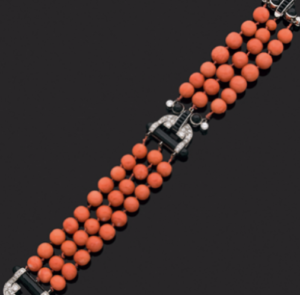 Professional Pearl and Bead Stringers will instantly know what wrong with this picture. And, our reaction is the same “WHAT???!??” we experience in high end department or jewelry stores when we see jewelry with similar issues…which all too often we do.
Professional Pearl and Bead Stringers will instantly know what wrong with this picture. And, our reaction is the same “WHAT???!??” we experience in high end department or jewelry stores when we see jewelry with similar issues…which all too often we do.
In this case, the bracelet is from the early 1920s and a nice example of Art Deco. It is composed of coral beads, onyx and diamonds mounted in platinum.
The bracelet is part of an auction at a high end European auction house and its value is set at between $14,000 and $17,000.
But when you look at the image, where does your eye go?
Yes, of course, right to the stretched thread at the clasp, central ornament and between the beads.
Obviously, this is unsightly, frankly, it’s unacceptably unsightly. But, in addition, it’s dangerous. We site knots between beads to prevent them from rubbing against one another and also to prevent loss when and if the thread breaks. (The idea is that if the strand breaks, only one bead will be in danger of being lost.)
Here, I would judge breakage to be inevitable and sooner rather than later. (I could be wrong, of course, but it looks like a pretty easy call to me.) So, in addition to looking terrible, at the least one bead from a valuable bracelet could be lost.
(And, as an aside I would note that these beads would be difficult to match given the scarcity of coral, especially Mediterranean coral, on the world markets.)
In its description, the auction house doesn’t mention the provenance of the jewelry – that is, who owned it, what house manufactured it, etc. But, even if the thread is the original thread (and it probably is), there is no value in it.
The opposite is in fact the case.
.

